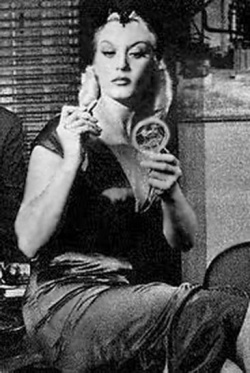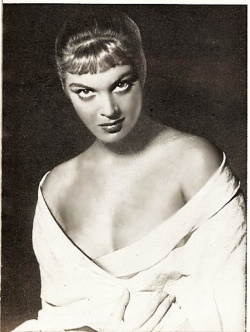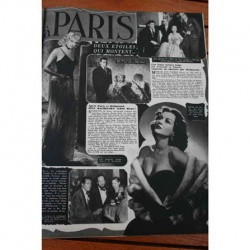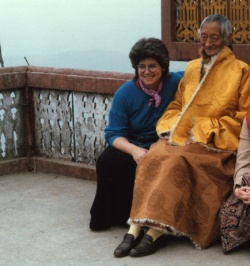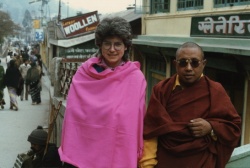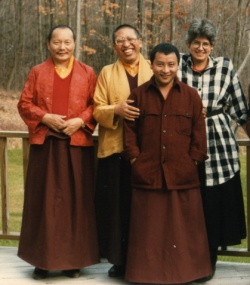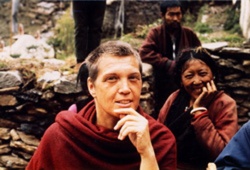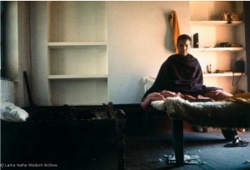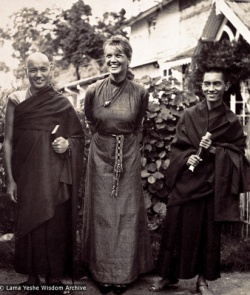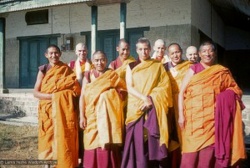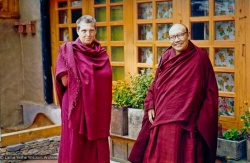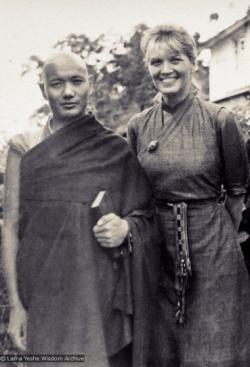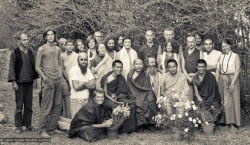The Russian Princess Buddhist Nun
When we see the words ‘royalty’ and ‘Hollywood’, most of us immediately think glamour, richness and indulgence. Many of us are envious of the lifestyle that Hollywood actors and actresses lead… or have, at one point in time, thought about what it would be like to be leading the life of a movie star!
If you were given the opportunity to be reborn as both royalty and a Hollywood actress, would you take it?
Zina Rachevsky was both “royalty” and a Hollywood actress. She was also born into an incredibly wealthy family, where her grandfather was the founder of SW Straus & Co.
SW Straus & Co was a mortgage and bond banker, who created the first mortgage real estate bond in 1909. In 1922, they were established to hold loans across the United States amounting to $150,000,000. Remember, this was back in 1922! They also owned hotels in LA and New York, and built what is now known as the Metropolitan Tower in Chicago… it was the tallest structure back then!
Zina’s mother, Harriet Straus Rachevsky, was a heiress and one of the richest women in the US. Her father was Vladimir Rachevsky, who was the brother-in-law to the Grand Duke Boris Vladimirovich Romanov (a direct descendant of Czar Alexander II of Russia).
Her father did not have direct royal blood, but during the 1920s, so long as there was any connection to royal blood, royal titles were freely used on foreign soil to impress people. For Zina’s father, the title stuck in America.
Her father and mother both met in Paris, and secretly wedded. In September 1930, Zina was born in the Ambassador Hotel of New York. She was known to be a bright and smart girl… and being brought up in Hollywood, she became the typical product of Tinseltown.
She became a Hollywood actress, but was better known as an international socialite. She made it onto the headlines of newspapers and front covers of magazines, as she was actively involved in love and drug scandals.
She was beautiful, Marilyn Monroe-esque and wild. At the age of 18, she married Count Bernard d’Harcourt for 2 years… and during that time she changed her Hollywood name from Princess Zina to Countess d’Harcourt.
Her life continued to be as colourful as her background… who would have thought that Zina would also be, according to Lama Yeshe, the “cooperative cause for the existence of Kopan Monastery.”
It was Zina who wanted to create a place where creative people could convene and learn meditation from Lama Zopa and Lama Yeshe. From her idea, came Kopan Monastery!
I have been and still continue to be inspired by Zina, her meeting with the Lamas, her contribution, her temper, her diva-like character, her transformation, her faith in the lamas and eventually her ascending into Kechara Paradise as said by Lama Yeshe, Trulshik Rinpoche and Kyabje Zong Rinpoche. I am so happy Zina is in a good place now.
I read Zina was not an easy person to be around. Very temperamental, very difficult and controlling. She had a hard time getting along with many people. She would even attempt to control Lama Yeshe who was compassionate enough and skillful to ‘tame’ her into a dakini like lady. Her being very difficult inspires me more. Because often in Dharma organizations you expect everyone to listen to Dharma, accept and transform so you have angels running around. But the opposite is true of this. Many respect, listen and accept Dharma but few actually practice to the point of transformation. That is a fact. And if you ‘push their buttons’ like Lama Yeshe was legendary for doing, they can run away in a blink of an eye. Many do run. They even ran from Lama Yeshe! Some came back and some didn’t. But that is ok, in time they will realize what they lost and will have a turn around. Zina was temperamental, wealthy and wanted to create a place for all her arty socialite friends to have respite on weekends for detox, spirituality and truth. She was very sharp and knew the party life was going to get her and her friends nowhere, so that is how Kopan got conceptualized in a nut shell. And look what it has grown into today. How beautiful. You have to read about Zina and be inspired.
You have to read about Lama Yeshe and be double inspired. I reproduced everything here to let the world know how wonderful Zina was and how anyone from any background can transform. I wanted everyone to know how wonderful Lama Yeshe was. I have admired, respected, loved and deeply trust in Lama Yeshe since very young. I use to read about Lama Yeshe and wished when I grew up I can be like him (far from being like him now) but I wished that very much. Reading about Lama Yeshe always brings tears to my eyes and chokes me up because you can feel his extraordinary love even from his pictures. I really want the world to know about him and what he has done. Therefore I reproduced this here.
Read the post below written by David Lai to read more about Zina’s journey to nunhood!
The legendary Zina Rachevsky was the earliest Western student and patron of Lama Yeshe and Lama Zopa Rinpoche. Everything about her including her royal heritage had become legendary. Her family was incredibly wealthy to begin with. Her grandfather established SW Straus & Co. that held loans on a string of buildings across the United States that was worth $150 million dollars in those days.
In 1930, her grandfather passed away and it was also the year that Zina was born. She was a precocious, intelligent and an independent child. She grew up to be a Hollywood actress and gained her reputation as an international socialite. She married Count Bernard d’Harcourt when she was only 18 and then divorced him two years later. At one point, she would be seen with the likes of screen legend Marlon Brando. She would later give birth to a son, Alex by Conrad Rooks, a troubled filmmaker and a daughter, Rhea Rechevsky.
Her apparent royal background was really not what it seems and it was a part of her family lineage that she embraced in order to avoid anti-Semitic backlash considering the other Jewish part of her family line. Her father was the brother-in-law to the Grand Duke Boris, the last of the Russian Romanovs. Her father and his wife, Harriet got married in 1929, about 12 years after the Russian Revolution. It was her family ties with the Grand Duke that Zina assumed her identity as the wild Russian Princess and it became a part of her larger-than-life persona that many still remember her by.
Zina had everything – money, fame, beauty and a string of marriages and relationships but she was deeply unhappy and that triggered her soul-searching. In 1965, Zina came to India and it was in India that she encountered Lama Yeshe and Lama Zopa. Before meeting the lamas, she had read about Domo Geshe Rinpoche in Alexandra David Neel’s book. To her delight, her guide brought her right to Lama Zopa, who was also known as Domo Rinpoche simply because he was a tulku of Dungkar Gompa. Domo is the name of the area around Dungkar monastery and tulkus of the monastery is traditionally named after the area. Lama Zopa and Lama Yeshe at that time never had any encounters with Westerners and Lama Yeshe was pleasantly surprise to learn that Zina came to them in search of enlightenment. At that time, the Tibetans regarded Westerners as mere spiritual barbarians, unable to perceive the value of the Dharma. Zina with her characteristic intensity shattered that view.
Thus began her involvement with Lama Yeshe and Lama Zopa with a long line of endless questions. Her thirst for the Dharma was unquenchable and her faith in Lama Yeshe and Lama Zopa was equally unwavering all through the years. In the earlier days, she would also request Lama Yeshe to teach a meditation course but he would refuse, probably due to his limited English vocabulary in those days. So, she turned to Lama Zopa to teach and after pestering him, he finally agreed with Lama Yeshe’s approval of course. At the same time, she brought many Western students to study with them. She returned to America to share what she had learnt and celebrated thanksgiving at Mary Jane “Max” Matthews’ home. Max Matthews or Mummy Max as she became affectionately known would eventually become a key sponsor of the monks and Kopan Monastery. She later became ordained as a nun as well.
In the beginning, it was obvious that Zina was in control. She was extremely thirsty for the Dharma but didn’t know anything about Buddhist traditions and rituals. On one occasion, Max purchased an antique statue and excitedly showed it to the Lamas. Lama Yeshe said that the statue looked pretty good but he wanted to examine the holy items encased within the statue. So, Lama Zopa and Lama Yeshe performed a puja in Max’s bedroom, which was in the basement of the house. The puja was to ritually open the statue and after examining the items within and then another puja was performed to consecrate the statue again.
However, everyone else just went upstairs and started to party away and forgot about the chanting lamas in the basement. Later, they felt an energy emanating from the basement and the soft sounds of the bell and the tapping sound of the damaru wafted through. They went downstairs only to realize that the energy came from the statue. Apparently, the statue was very old and that it contained holy relics of the previous Buddha. Everyone sat in a semi-circle to bask in the holy energy that permeated the room. A deep conversation soon ensued about what everybody wanted to do with their lives. Zina confessed that she had created a lot of bad karma in this life and that she wanted to ‘make up’ by creating a place where people could come, work and study the Dharma with the lamas. That was how the idea for Kopan monastery was born.
Zina would promote her Lamas with whomever she met and even brought a French film crew to Tibet in order to film Lawudo cave in Khumbu. Lawudo was where Lama Yeshe was born and the cave was the place where Lama Zopa’s previous life meditated in. Over time, she bought land and founded Nepal Mahayana Gompa Retreat center that eventually became Kopan Monastery in Nepal. Even as she was devoted to her Lama, she found herself constantly arguing with Max. Although far removed from their familiar environment, one thing remained the same – they were both used to being the center of attention. Some American students were shocked by the manner in which Zina and Max fought for ‘control’ over the lamas that these students would repeatedly reassure the lamas that not all Americans behave in this manner. In those days, Zina would be over-protective of Lama Yeshe and she would not let anybody meet Lama Yeshe and she would tell visitors that Lama is busy. It seems that she wanted to keep Lama Yeshe all to herself.
Some were even shocked by the manner in which Zina had housed the lamas. At Kopan, Zina stayed in a large bedroom decked with a luxurious white carpet and a leopard-skin bedspread while Lama Yeshe and Lama Zopa lived a spartan existence in a tiny little dark room with 2 beds behind the house. However, the Lamas never complained. Generally, people cursed Zina under their breaths because she had little regard for other people’s possessions. However, nobody had the heart to be really angry with Zina because she was still a genuine friend. By and large, she was friends with everybody and yet she was close to nobody.
In 1970, Zina travelled with Lama Yeshe, Lama Zopa and some other western students to be ordained in Dharamsala. The ordination took place at Chopra House, Kyabje Ling Rinpoche’s residence just outside McLeod Ganj. Geshe Rabten presided over the ceremony along with Lama Yeshe, Gen Jampa Wangdu, and two other monks. This was done according to tradition with four monks and an abbot as required for monastic ordination ceremonies.
Towards her last years of her life, she entered a long solitary retreat and midway through the retreat, Lama Yeshe suddenly decided to meet her. He hastily made his way to see her and he talked to her extensively. That would be the last time they would meet in this life. Not long after, Zina Rachevsky passed away which some say was from food poisoning and some say from hepatitis but post-mortem tests showed that she had died of cholera.
During her last moments, her stomach was said to have swelled up like a basketball and she had terrible cramps in her legs that prevented her from folding her legs. So, she sat there with her legs stretched out while reciting mantras until she died. While Zina was dying, a close student informed Lama Yeshe. He immediately entered into meditation and after awhile, he came out of meditation and told the student that he had performed mind transference (Powa) and sent Zina Rachevsky to Kechara Paradise – Buddha Vajrayogini’s pure realm. Kyabje Zong Rinpoche later confirmed this and Trulshik Rinpoche also said that she had “a good death.”
In the Buddhist tradition, the manner in which she passed away was auspicious because she spent her final moments in deep spiritual practice. She led her life to the fullest from her Hollywood days to renouncing everything when she met Lama Yeshe and Lama Zopa. She studied extensively, sponsored her Lama, established a whole monastery and brought many students to her Lama. Apparently, she had taken rebirth as a French boy and was recognized by Sakya Trizin Rinpoche to be her reincarnation. Zina’s story serves as a great inspiration for her generosity, perseverance and her genuine thirst for the Dharma. This goes to show that anybody from any part of the world can just take a leap of faith and go all the way with the Lama’s teachings and building projects.
By David Lai
Tsem Rinpoche
www.tsemrinpoche.com
Zina Rachevsky - Jewish Princess - And The Tibet Connection
With Tibet in the news recently, I thought I’d expand on a piece I have on my website about my cousin Zina Rachevsky and my travels in Nepal.
Zina Rachevsky
In the 1980's I lived in Woodstock, NY, practically in the shadow of the Tibetan Buddhist Monestary Karma Triyana Darmachakra (KTD). Although I was not a practitioner, I lived with one, which I thought gave me some in-law status.
In 1983 or 1984, my partner and I decided to go to India and Nepal. She wanted to see the Lamas and Tibetan Buddhist shrines and I was in search of information about my cousin Zina Rachevsky, who, it is told, had been the first foreigner to study with Tibetan Lamas, (or second after Alexandra David Neel.)
Zina and her family had always been somewhat of mythical figures in my family. For one thing, the Straus family was fabulously wealthy. In 1921, Simon William Straus - (Zina's grandfather, my grandmother's brother) founder of SW Straus & Co., held loans on new buildings across the us worth $150,000,000. (NY Times, Dec 3, 1922) In 1924 they completed construction on the Chicago building that is now known as Metropolitan Tower, the first Chicago structure taller than thirty stories. It was then known as "The Straus Building." SW Straus owned the Ambassador Hotels in Los Angeles, New York City and Atlantic City. He died in 1930. The company went into recievership, it went under, in 1932 after defaulting on bonds totaling over $200 million.
Zina was born in 1930, the same year her grandfather died. Zina was known to us a wild child, but in the 1950's, when I was a child listening to the stories, that could be another way of speaking of an independent, curious woman. She spent much of her early adulthood working as actress and gaining a reputation as an international socialite, knew the Beat Poets, and eventually made her way to India and finally to Dharma.
Zena's father, we knew, claimed Russian nobility. While the Russian nobility fable is a large part of Zina’s current mythology, in my family we were more interested in our side, the Jewish side. Zina's mother and my mother were first cousins. Zina's grandfather and my my grandmother were siblings. They were all German Jews, who had been in the United States since the middle of the 19th Century, and had made their fortune first as peddlers, then as bankers with huge real estate holdings throughout the country. They settled first in Ligonier, Indiana, creating one of the first and largest Jewish communities in the midwest. The family then moved on to Chicago and then to New York.
Zina, in the stories written about her, is usually referred to as a Russian Princess. It is not likely that Zina actually thought of herself as a Russian Princess. Certainly the rest of the family knew that her common-born father's common-born sister had married a dethroned Russian Duke, which doesn't equal royalty by any inheritance laws anywhere. Not a drop of royal blood coursed through her veins. However, it was a clever way of branding herself when she was creating a name for herself as an actress and a showgirl. The meme seemed to have stuck with her friends and acquaintences and became part of her public persona. Certainly, it made her memorable, and most likely reduced the amount of anti-Semitism that might have been an obstacle in those days.
Update: It turns out, in fact, that the Russian Rachevsky's were most likely Jews as well. Converted to Catholicism, for various reasons, but Jews. Did Zina know this? I don't know. But it seems that she was, by blood, 100% Jewish.
I didn’t think much about Zina until I became interested in Tibetan Buddhism. She had visited us in New York only once, but I had no memory of her. But when I found that Zina had been involved with Lamas in India and Nepal soon after the Chinese invasion of Tibet, I knew it was something worth investigating.
In 1965 Zina was in India, and, according to "official" versions she asked Lama Yeshe and Lama Zopa instruct her in Tibetan Buddhism. On the other had, I recently interviewed someone (who prefers not to reveal his name or sources publicly) who told me that while Zina was searching for a teacher, the two lamas heard about the wealthy American in town and courted (my informant actually said "hijacked") her for her money and European/American resources. At any rate, they had never taught a foreigner before, there was no precedent for it, but they began to teach her. Zina brought more and more European and American students to study with them. Soon she bought land and founded a retreat and study center at Kopan in Nepal. Some versions of the story say that Zina wanted to start a nunnery but the Lamas opposed her and started the retreat center instead. She had the money but they had the Buddhist /political connections.
"One day in 1965 an extraordinary thing happened. (to Lama Zopa and Lama Yeshe) Into their room burst the most unlikely figure of all. A beautiful, young, blonde ‘princess’ of Russian descent, by the name of Zina Rachevsky. She was looking for the Domo Geshe Rinpoche, no doubt inspired by the romantic figure of Lama Govinda’s book, and was taken by mistake to Lama Zopa, who was also known as Domo Rinpoche ever since his stay at Dung-kar monastery in Tibet. Unaware of the mistaken identity she strode forward and boldly ask: “How can I receive peace and liberation?”
"To say the two lamas were startled would be an understatement. No foreigner, especially the dreaded western ‘barbarian’ had ever entered their quarters before. No ‘barbarian’ had ever spoken to them like that before. And certainly, no ‘barbarian’ had ever talked of wanting enlightenment.
"But then Zina Rachevsky was no ordinary person. Her life was, in its way, every bit as extraordinary as the two lamas’. Her father was a Russian prince, a Romanov who had fled the Russian Revolution, her mother an heiress, one of the richest women in the United States. Zina was brought up in Hollywood, and became a typical product of Tinsel Town – spoilt, precocious, insecure, attention-seeking, deeply unhappy. By the time she was a teenager she’d already hit the headlines more than once, not only for her entrée into the world of starlets, but also for her involvement in various drug scandals. She was gorgeous, curvy, sexy, a Marilyn Monroe lookalike, wild and determined to live on the edge...
"By the time she met Lama Yeshe she was, quite bluntly, jaded. The drugs, alcohol, late nights, rich living and too many sexual entanglements had taken their toll. To the lamas, she must have justified their countrymen’s every prejudice about the degenerate, unspiritual, western devil. And so for a while they said nothing, merely looked.
"Was she real? Was she a fraud? Or was she, as Lama Yeshe suspected, someone very special? With his more mature wisdom he decided to test her. He explained to me: “I gave her some sort of answer, with my limited English, and after an hour she said she had to leave. To my surprise she asked if she could return the next day. I said “all right”. And she did come and asked more questions, and I gave teachings. For one week she made the journey by jeep to see us, and then asked us if we’d be prepared to go and visit her.”
"Lama Yeshe hesitated for a moment. The step he was about to take was irrevocable. At this point Lama Zopa stepped in. With all the zeal of his youthful Bodhisattva’s heart he begged Lama Yeshe over and over again not to forsake this woman who had come seeking his help. Lama Yeshe still demurred. Did Lama Zopa know what he was asking? Could he be aware of the enormous responsibility that they were about to initiate and which would one day fall solely on his shoulders? Was he prepared for all that was on the verge of being brought into effect?
"But the Bodhisattva promise, which they had both taken, is not written in sand, which the tide can wash away, but hewn out on rock and stands for all time. They both knew, of course, they could not refuse anyone sincerely seeking the truth. And so Lama Yeshe and Lama Zopa set the wheel of Dharma turning for the West, and daily for nine months gave Zina Rachevsky the teachings she so earnestly desired. It must have been a mutually fascinating exchange. If Zina was intrigued by the holy men she had stumbled upon, they must have been transfixed by her. As Lama Yeshe told me, “She was very dissatisfied with everything! She said her life was empty and had no ‘taste’. She’d done everything in life, but still could find no satisfaction. I could see what she was saying. In comparison I had nothing – no country, no home, no money, no possessions, no family, and yet I had everything. With Zina, and later with other westerners, I began to enquire about their lifestyle. I realized that what Zina lacked was an understanding of herself, her inner life. She lacked an understanding of her own potential to be happy. She thought happiness came from without, but it does not, it comes from within.”
"Zina had finally found the meaning that had been lacking in her frantically sad life. When her nine months of private tuition were over, the expiry of her visa forced her to return to Sri Lanka. She then bombarded the Dalai Lama with letters entreating him to give Lama Yeshe and Lama Zopa permission to visit her in Sri Lanka. When permission was granted, Zina returned to India to escort her lama, but on the spur of the moment decided to go with them first to Dharamsala to try and get an audience with His Holiness personally. Once there she became convinced that her true vocation was to become a nun. Again Lama Yeshe stopped in his tracks. Having a western female disciple was one thing, having one with a shaved head and red robes was another. “I thought about it for a while,” he admitted, “then decided it was all right! It even seemed like a good idea. So I asked the Dalai Lama personally if he would ordain Zina.” Vickie MacKenzie
I am intrigued that Zina's story is told with such an air of authority, but still manages to get things wrong. Zina's father was not a prince. He was a common born brother -in law- to the Grand Duke Boris. He and Harriet married twelve years after the Russian Revolution. Probably he was broke, and expected Harriet to supported him. They married in 1929, SW died that year, and the family lost their fortune during the depression.
The "official" story by MacKenzie and others also ignores the possibility that the Lamas were using Zina for her wealth. They are written to make the Lamas appear pure and noble, and Zina miserable and spoiled and then redeemed by Buddhism. ("With all the zeal of his youthful Bodhisattva’s heart he begged Lama Yeshe over and over again not to forsake this woman who had come seeking his help.") Not that Zina didn't want to study Buddhism, I'm sure she did. But it seems to me that they were as dazzled and interested in her "royalty" and money as they were in the possibility of teaching a foreigner. Either way, there is no proof, only the stories that are told and retold.
As to Zina's "frantically sad life"? Harriet and her sisters all had a reputation in our family for being over the top in their youth. But even within families people's lives become myths, and our stories are recast as scandal and gossip. I would describe Zina as smart, driven, creative and adventurous. Why claim that she was "spoilt" "attention-seeking" and "deeply unhappy" as Mackenzie does? The problem with anecdotal history is that it easily becomes fable, and you don't know what to believe. Who is casting her in this light? Vicki Mackenzie doesn't cite her sources. I ask, in whose interest is it to portray Zina as morally and spiritually deficient and the Lamas as noble and pure?
I did my early research on Zina without the aid of the internet or google – they didn’t exist yet. I relied on information from my relatives. Now Google searches lead to endless variations on the theme of the spoilt unhappy Russian princess begging for the teachings Lama Yeshe and Lama Zopa, beginning the trickle that became a wave of Westerners studying Tibetan Buddhism.
In 1983 (or 1984) I visited Kopan, the retreat center she founded, looking for people who had known Zina. With much difficulty I did find a couple of people willing to speak to me, but so reluctantly that I decided not to pursue it further. I puzzled over their reluctance to discuss Zina. If she had founded the center, surely someone would be willing to discuss her, tell me about her time there, her role in the founding. But to the contrary, people shunned me. People said, "someone else knew here but he's not here," or "he's here but he's busy," or "nobody here knew her." It felt wrong. I had the distinct sense I was being lied to, or purposefully avoided. I couldn't figure out why, or even if it was true, since it was just my feeling. I decided to drop my investigations because I kept bumping into walls of silence. It was only after another two decades that I began my investigation again.
Zina died in the early 1970's halfway through a meditation retreat, possibly of peritonitis, and supposedly enlightened, leaving her young daughter to be raised by her grandmother, Harriet. Her son, Alex, was with his father Conrad Rooks, the filmmaker who directed the 1972 film, Siddhartha. Alex is now also a filmmaker.
Harriet, Zina’s mother, whose family had fabulous wealth and lost all of it, died Los Angeles in the nineties, having raised Zina’s daughter. Zina’s Russian dad - I don’t know what happened to him.
I'm sorry I never got to know my cousin Zina. I'm sure that this woman who went from young Jewish Princess to actress/showgirl to Beat traveler, to Buddhist pioneer must have been amazing . I love how full her story is, how complex. It is said that she has reincarnated as a Swiss boy. I hope our paths cross someday. Stranger things have happened.
See more about Zina and her family.
H.E. Kalu Rinpoche
While in Nepal we had the great fortune of meeting with H.E. Kalu Rinpoche, a venerable, powerful, and ancient Lama. (check this link for a fascinating interview with June Campbell about the inherent misogyny of the rinpoche/tulku system that underlies the transmission of power in Tibet.) He was sick in bed, but graciously invited us into his bedroom to talk to him with the help of an interpreter.
I told him that I really didn't want to take refuge (a term for accepting Buddhism - not necessarily giving up your birth religion) because I could hear my Jewish Grandmother rolling over in her grave. Kalu Rinpoche pantomimed kissing a mezzuzah. I found that totally endearing. I then promptly kneeled into his wooden soup bowl, which for some reason was next to me, and spilled it all over the floor. Then my grandmother really started screaming at me. "This nice old Tibetan Rabbi has taken time from his sick bed to talk to you and you spill his soup??? Clean it up!" So, there was nothing I could do but take refuge. It was lovely. Really.
More Lamas
In our travels we depended on the kindness of Lama Norlha Rinpoche, an esteemed teacher living near Woodstock, NY. We stayed with his family at his mother's house in Darjeeling. We arrived before he did, and our only address was a scribbled note with the name of the street and the word, "petrolatum" We asked our driver to go to Petrulpum, and after searching for about an hour we finally realized that it wasn't "petrolatum" one of us had transcribed Lama saying Petrol Pump. The house was located next to the petrol (gasoline) station. It wasn't a gas station as we knew it, but it was the gasoline pump. So much for translating English into English.
Lama Norlha was always telling me I should do a three year retreat. I'm sure he was half joking, half not. While I loved meditating with him, there was just no way I was about to give up three years of my life for it. Maybe if I could have worn pink robes instead of maroon.
In Nepal spent time hanging out Trangu Rinpoche in Darjeeling. I know this sounds really casual, but it's true. When the Lamas came to the States they were surrounded with ceremony and devotees. But back home, they were incredibly welcoming and relaxed. I think we had tea with Trangu Rinpoche at his place several times. Just him and the two of us.
One day Trangu Rinpoche invited us to go on an expedition with him. This involved taking a long trip on a very dusty road in an old auto that broke down. We ended up joining a group of people in a rickety old bus after hiking for miles. The bus was fine, and actually rather fun, but the roads were so dusty that we had to wrap our heads in our shawls just to be able to breathe. I have no memory of where we went.
When Trangu Rinpoche came to Woodstock later that year we invited him and some of the other Lamas to lunch at our house.
Khenpho Karthar Rinpoche
was the abbot at KTD.
Bardor Tulku Rinpoche
was teaching there as well. Here we are on my deck. That's me in the Norma Kamali shirt with huge shoulder pads. Maybe I would actually have looked better in the maroon robes.
